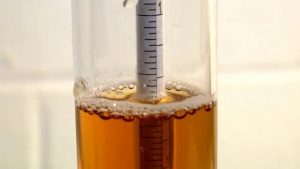Today we’re going to talk about how to back sweeten wine. Many of you probably started out with wine kits that come with a flavor pack to help you sweeten your wine. Maybe you’ve moved over to fresh fruit or you’re wondering how to make your kit a little bit sweeter to meet your tastes. This article will help you sweeten your wine to meet your tastes.
If you don’t know the basics of making wine and are just starting out, I recommend you read our article on how to make wine for beginners.
In much of the world, wine is finished dry. That means that pretty much all of the sugar has been converted into alcohol. Back sweetening, or chapitalization, is the act of adding sweetener to a wine. Chapitalization is actually illegal in some European countries. However, in the US, most wine drinkers actually prefer sweeter wines. This makes the process of back sweetening a wine pretty common there.
A Little Bit About Back Sweetening a Wine

So let’s talk about how you’re going to actually back sweeten your wine. First of all, I recommend finishing your wine dry, aging for however long you want, and then back sweetening. It’s just very difficult to start with higher specific gravity and try to “stop” the fermentation process before you are dry. If you’re going to back sweeten a wine it probably doesn’t need to age quite as long as a fine dry wine. You’re going to mask much of the flavor profile with the additional sweetener.
One thing that we all know is that yeast feeds on the sugars in our fruit juice. So if we just blindly add sugar we’re likely to restart fermentation. There are different types of fermentable sugar you could add to back sweeten wine and get different flavor profiles. Some of these fermentable types of back sweeteners include sugar, brown sugar, honey, corn syrup, fruit, and fruit juices (raw or concentrated).
I believe a lot of fruit winemakers will choose to add additional juices to sweeten their wine. This gives the finished wine a very strong and fruity flavoring. Almost like drinking the pure fruit juice with very little alcohol flavoring.
There are other artificial sweeteners you could choose also. I tend to avoid these sweeteners because they tend to have off after tastes. The benefit of artificial sweeteners or none fermentable sweeteners like Stevia is that they will not cause fermentation to restart. However, you can stop the fermentation from restarting when you use fermentable sugar with additives. Let’s take a look at the actual process of how to back sweeten wine.
How to Back Sweeten Wine
- Finish your wine out dry and age it like normal.
- Decide on the sweetener you are going to use on your wine. We’ll use plain old white sugar for our example.
- When you are ready to bottle add potassium metabisulfite and potassium sorbate per the instructions that come with the products. This will help stop the wine from starting a new fermentation.
- Let the wine site for about a day to disperse the additives.
- Make sure you have a hydrometer.
- Take a few samples of wine and put them into wine glasses.
- Add small but increasingly stronger amounts of sweetener to each glass.
- Taste each glass to determine which one meets your expectations.
- Once you have decided on the right sweetness, dump the remaining wine from the glass into your hydrometer and read the specific gravity. This will be our target specific gravity.
- Slowly add the sweetener to your larger batch of wine.
- Periodically check the specific gravity.
- Once you hit your target specific gravity stop.
- You have now back sweetened a wine.
- The next step is to bottle. Since we’ve already added potassium metabisulfite and potassium sorbate you can bottle immediately.
Conclusion
In conclusion, there are a variety of methods for back sweetening wine, each with its own advantages. Each method should be used with caution to ensure the sweetness is not overpowering and can be adjusted to the individual tastes of wine drinkers. Ultimately, the decision of which method is best will depend on the type of wine, the desired level of sweetness, and available resources. The best method to back sweeten wine will depend on the situation, but with the right technique and ingredients, any wine can be back sweetened to create a balanced and enjoyable flavor.